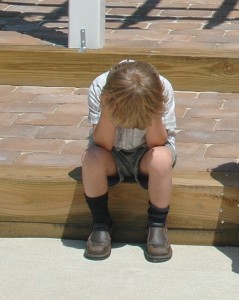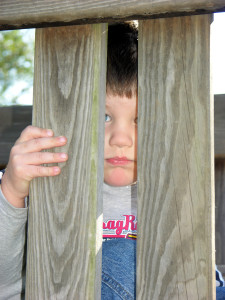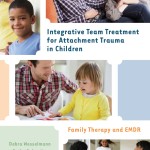Category Archives: Uncategorized
“Now that I understand this is dissociation, I’m not mad at him anymore,” said his mother.
 Dissociation in children is poorly understood. I have always had mixed feelings about speaking with parents about signs of severe dissociation in their child, because I have been afraid that the discussion would lead the parents to pathologize the child. Yet, this is a real phenomenon, and when dissociation is not recognized, affected children can end up feeling rejected by their confused and frustrated parents.
Dissociation in children is poorly understood. I have always had mixed feelings about speaking with parents about signs of severe dissociation in their child, because I have been afraid that the discussion would lead the parents to pathologize the child. Yet, this is a real phenomenon, and when dissociation is not recognized, affected children can end up feeling rejected by their confused and frustrated parents.
Dissociation can be experienced at varying degrees of severity. We all experience slight dissociation when we are bored, example, and “space out” or “day dream.” Very young children experiencing trauma dissociate or “go away” mentally because they have no other recourse. They are not big enough to fight or flee. Regular early dissociation wires the brain to life-long dissociation.
The “Structural Dissociation Model” (van der Hart, Nijenhuis, & Steele) posits that severe traumatization leads to little “Emotional Parts” (EPs) of self that are separated off from the front part of self in order to keep memories and their associated emotions at bay. From a neurological point of view, the EPs are neural networks of unmetabolized stored trauma and emotion in the back of the brain. When the memory or emotions are triggered, the trauma survivor begins operating out of that EP, and the individual completely or nearly loses access to what I call the “Front Part of Self.” When the trauma survivor is back in Front Self, his memory for what he was thinking or feeling when dissociated may be confused or even absent.
One mother and father who previously reacted angrily to their child’s sudden switches and seemingly bizarre behaviors have new insight regarding the phenomenon of dissociation. They report that because of this understanding, they have been able to remain calm and much more effective in keeping their child regulated. I am now convinced that education about dissociation can increase compassion and support for this vulnerable population. I will write more about dissociation in later blogs.
When feelings are the trigger…
 Children (and adults) who experienced inadequate comfort and nurturing as infants and toddlers are frequently unable to manage any sort of emotion – positive or negative – without becoming dysregulated.
Children (and adults) who experienced inadequate comfort and nurturing as infants and toddlers are frequently unable to manage any sort of emotion – positive or negative – without becoming dysregulated.
Early deprivation leaves inadequate connections in the prefrontal brain. The prefrontal brain is like Grand Central Station, connecting the higher and lower regions of the brain and also the right and left hemispheres. The logical regions of the brain are not able to manage the emotional areas.
Another way to understand this is to think about the dependency of infants upon their caregivers to manage their emotions for them – to provide comfort and soothing when they are frightened, in pain, or stressed. When there is not comforting attachment figure, the infant learns that feelings are not safe. The infant learns the only way to cope with feelings is by shutting down. Feelings of any sort become a source of fear.
Children need their parents’ help to develop integrated brains. They need assistance to access logical thought – to step back from their emotions a bit and contemplate them – to ride out the feelings, and to find ways to feel better. It takes time and patience, but it’s an investment parents can make now that will be well worth it in the end.
Adults with a traumatic history need assistance as well, with skilled therapy and development of coping skills. Traumatized children and adults are a vastly misunderstood population.
What are your child’s triggers?
Homework? Being told no? An angry face or voice tone? Bedtime? Getting up? Holidays? If you can identify his triggers, you might be able to make an educated guess regarding the negative beliefs driving his or her behaviors.
Some children have the stuck belief, “I never get what I want!” Children who have suffered losses or big disappointments are especially triggered by the word no. It’s like all of their past feelings related to disappointment all surface at once, and they become overwhelmed by their big feelings.
Another common stuck belief is, “I can’t trust others to care for me and give me what I need (and I might die if I don’t get what I think I need!)” Therefore, “I have to be in charge of getting my own needs met – any way I can!” Children can’t put their stuck beliefs into words – unless they have some therapeutic help. But the stuck beliefs unconsciously drive their behaviors and lead them to plead, demand, and sneak or steal whatever they think they need. Imagine if you truly had a feeling that you would die every time you didn’t get something you wanted. Any of us would resort to desperate measures to protect ourselves!
Children who meltdown around homework often have a stuck beliefs, “I can’t do it! It’s too hard!” Sometimes with patience and understanding, parents can help children over this stuck belief. Some children need some therapeutic assistance.
Children who are not living with their original families often have the stuck belief, “I don’t belong.” Holidays, birthdays, and attention paid to siblings are especially difficult for children with insecure feelings related to being wanted and loved. Calm attunement and reassurance from parents, over and over, again and again, can gradually chip away at this stuck belief.
Anytime children are in heightened emotions, anger only escalates the problem and reinforces their mixed-up thoughts. To calm reactive children, give them extra doses of affection, hugs, rocking, holding, and reassurance (and sometimes therapeutic assistance.) Over time (and it does take time!) they feel better – which results in better behaviors. Think of it this way — the investment of time and energy now will save you many heartaches down the road.
Dissociation is a normal and self-protective response.
Dissociation is a normal human response to intense emotions or even to boredom. Everyone dissociates to some extent, but children who have experienced multiple traumas are high risk for dissociative disorders. As children or adults, they may regularly shut down or space out, or they may become hyper and extremely silly or behave in other ways that appear strange. In severe cases of dissociation, traumatized individuals (adults or children) may exhibit fast changes in their emotions and behaviors. Hollywood has dramatized dissociative disorders with movies like Sybil and The Three Faces of Eve. I believe these dramatic portrayals have increased the stigma and shame around the problem and prevented many people from seeking and receiving proper treatment.
Individuals with dissociative disorders first learned to dissociate as young children, in order to avoid becoming overwhelmed by intense fear or distress. This is a response that is self-protective and, in a way, sensible. When dissociation becomes a hard-wired pattern, it serves to help individuals avoid the distress related to feelings and memories. Such avoidance is problematic, as it can prevent sufferers from being able to work through and resolve traumatic memories. Over time, dissociation can become a habitual response to any sort of stress, which can lead to problems in functioning in daily life.
Attachment relationships protect us from the effects of stress and trauma. Individuals with dissociative disorders almost always struggle with feeling safe and secure in their attachment relationships. Therapy should always include relationship help. Parents should be guided in increasing emotional attunement and support. Dissociative disorders in both children and adults should never be dramatized or pathologized. The focus should always be on the whole person and not on separateness between parts of self.
Guided visualization can assist in developing a sense of safety for younger parts of self and strengthening the “front part” or “most mature” self. Any “parts work” or dialoguing with parts of self should take place only after making sure the individual has access to feelings of competence and strength, is grounded in the present, and feeling safe.
Mindfulness is a Lifestyle
 Relaxation and meditation are extremely beneficial for reducing stress, reducing cortisol and inflammation in the brain, and calming reactivity. But mindfulness involves even more than activities that change consciousness. Mindfulness involves staying present to all of our experiences, including feelings of sadness, anger, hurt, loneliness, or any other emotions. The practice of mindfulness includes staying aware of tension or urges. When we are mindful, we experience our inner state without judgment, no matter what it may be. We are able to take a step back and think about what we are feeling and thinking without reacting reflexively. We are able to stay present and introspective. Without mindfulness, we simply react, and rid ourselves of any uncomfortable feelings as quickly as possible. We may find ourselves “letting loose” on anyone in our path, “numbing out” with TV, alcohol, or dissociation, or acting impulsively, making a bad situation worse.
Relaxation and meditation are extremely beneficial for reducing stress, reducing cortisol and inflammation in the brain, and calming reactivity. But mindfulness involves even more than activities that change consciousness. Mindfulness involves staying present to all of our experiences, including feelings of sadness, anger, hurt, loneliness, or any other emotions. The practice of mindfulness includes staying aware of tension or urges. When we are mindful, we experience our inner state without judgment, no matter what it may be. We are able to take a step back and think about what we are feeling and thinking without reacting reflexively. We are able to stay present and introspective. Without mindfulness, we simply react, and rid ourselves of any uncomfortable feelings as quickly as possible. We may find ourselves “letting loose” on anyone in our path, “numbing out” with TV, alcohol, or dissociation, or acting impulsively, making a bad situation worse.
Mindfulness may require an entire lifestyle change. It requires practice, conscious awareness and living with intention on a daily basis. Mindfulness is acceptance and openness to all the experiences of day-to-day life. Therapy is a wonderful way to develop greater mindfulness. So is the practice of meditation, yoga, prayer, or spiritual studies. There are many routes. Don’t allow yourself to go through life reacting, hiding, or numbing out. Live life fully.
Anger Management Is Not the Answer
 Many folks tend to think anger management is the answer when it comes to problems with anger and aggression. Sadly, I have never found anyone suffering from high levels of anger who benefited much from anger management skills. I think it’s all about finding what emotions and thought processes are driving the high level of reactivity and anger. Many children and adults with “anger problems” have difficulty tolerating intense feelings and lack feelings of safety and connection to others, leaving them with heightened feelings of distress, mistrust, and separation or alienation. They may carry negative perceptions of themselves, others, and the world based on early life experiences in which they learned it is not safe to trust or be close and came to believe they were inadequate. They are easily overwhelmed by fears, confusion, stress, and anxiety. Acute distress is triggered by interpersonal interactions, reminders of traumatic memories, and vulnerability due to fatigue, hunger, or loneliness. When our children have problems with anger, we have to look far below the surface. To do that, we have to be willing to hold our breaths and dive into their deeper emotions and thoughts with them, without judgments. Healing and changing deeper thoughts and feelings of reactive children requires walking with them on their journey with persistence, patience, and compassion.
Many folks tend to think anger management is the answer when it comes to problems with anger and aggression. Sadly, I have never found anyone suffering from high levels of anger who benefited much from anger management skills. I think it’s all about finding what emotions and thought processes are driving the high level of reactivity and anger. Many children and adults with “anger problems” have difficulty tolerating intense feelings and lack feelings of safety and connection to others, leaving them with heightened feelings of distress, mistrust, and separation or alienation. They may carry negative perceptions of themselves, others, and the world based on early life experiences in which they learned it is not safe to trust or be close and came to believe they were inadequate. They are easily overwhelmed by fears, confusion, stress, and anxiety. Acute distress is triggered by interpersonal interactions, reminders of traumatic memories, and vulnerability due to fatigue, hunger, or loneliness. When our children have problems with anger, we have to look far below the surface. To do that, we have to be willing to hold our breaths and dive into their deeper emotions and thoughts with them, without judgments. Healing and changing deeper thoughts and feelings of reactive children requires walking with them on their journey with persistence, patience, and compassion.
I Never Would Have Guessed….
 A child I was working with was having multiple tantrums every day, shortly after her adoption day. Her mother brought her in, fatigued, defeated, and confused. The mother said, “I think she is testing us to see if we really love her!” Certainly, this was a possibility. But I wondered about grief. After working with hundreds of adopted children over the years, I have been astounded by the immensity of their grief, and how often grief manifests as anger. The little girl’s mother was willing to follow my suggestions, and she cradled her daughter and rocked her side-to-side, telling her that all her feelings were normal and OK, and that it was perfectly normal if she was feeling sad. The little girl’s face crumpled, and she sobbed and sobbed, as her mother stroked her and attuned. The most important words that little girl heard that day was, “I’m so sorry.” Finally, her sobs subsided and she relaxed in her adoptive mother’s lap. By the end of the session we were all making silly faces—she had been able to release the torrent of emotion that had been bottled up inside. On the way out, her mother turned to me and said, “I never would have guessed she was grieving!”
A child I was working with was having multiple tantrums every day, shortly after her adoption day. Her mother brought her in, fatigued, defeated, and confused. The mother said, “I think she is testing us to see if we really love her!” Certainly, this was a possibility. But I wondered about grief. After working with hundreds of adopted children over the years, I have been astounded by the immensity of their grief, and how often grief manifests as anger. The little girl’s mother was willing to follow my suggestions, and she cradled her daughter and rocked her side-to-side, telling her that all her feelings were normal and OK, and that it was perfectly normal if she was feeling sad. The little girl’s face crumpled, and she sobbed and sobbed, as her mother stroked her and attuned. The most important words that little girl heard that day was, “I’m so sorry.” Finally, her sobs subsided and she relaxed in her adoptive mother’s lap. By the end of the session we were all making silly faces—she had been able to release the torrent of emotion that had been bottled up inside. On the way out, her mother turned to me and said, “I never would have guessed she was grieving!”
Integrative Team Treatment for Attachment Trauma in Children: Family Therapy and EMDR
 Treatment Manual for Clinicians. Read reviews and more here.
Treatment Manual for Clinicians. Read reviews and more here.
Adoption is Not the Problem.
Adoption is not the problem. Adoption is a win-win for adoptive parents, children, and birth parents. Adoption is not a problem, but early attachment losses and traumas are indeed a problem. Even preverbal trauma leaves an imprint in the limbic brain of young children and creates entrenched feelings of rejection, abandonment, hurt, mistrust, fear, and worthlessness. Children wired for rejection will misunderstand normal parenting discipline as attempts to hurt and reject them. Vulnerable feelings are quickly turned into anger as a method of self-protection. Mystified parents become angry in return, which triggers children to feel their pain even more intensely. There is a way out of this – but it’s not easy. Therapists and parents must work together as a team to assist children in experiencing feelings of love, trust, and closeness on a deep level.

